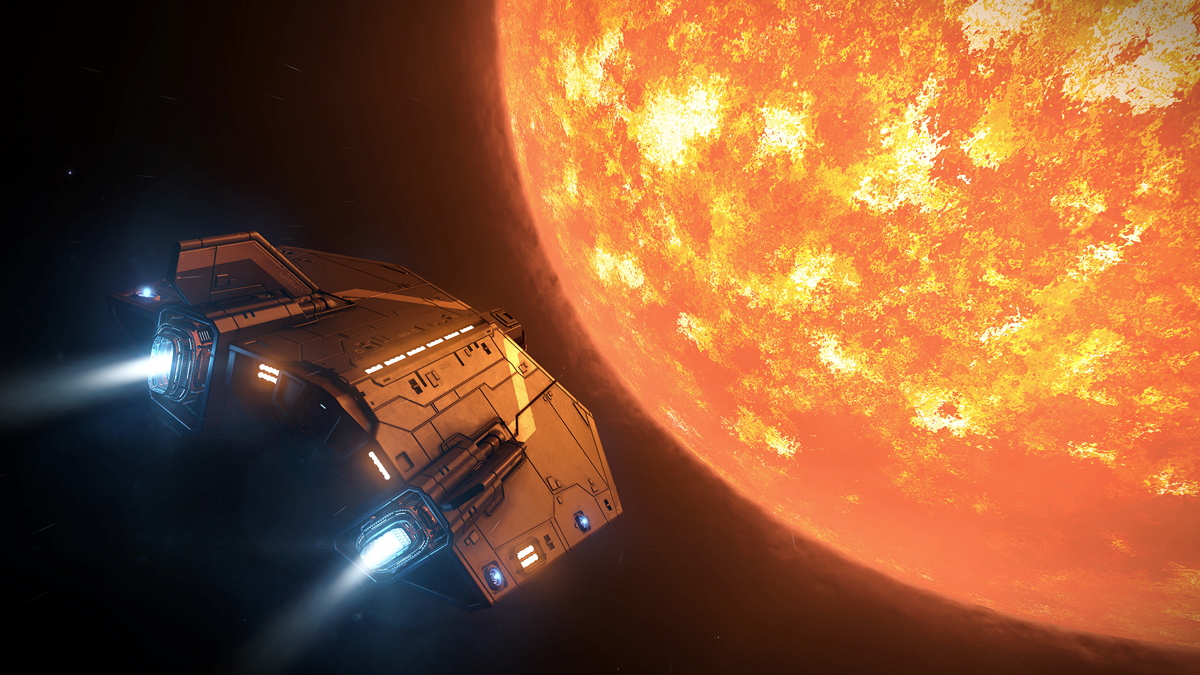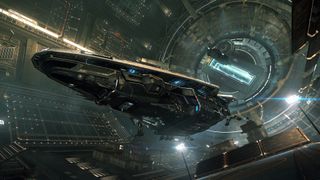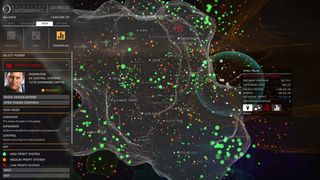Space Adventure 'Elite: Dangerous' Simulates Milky Way in Stunning and Accurate Detail

Instead of fighting, trading or hunting for smugglers, many players of the space adventure game "Elite: Dangerous" are turning tail and heading for parts unknown deep within the galaxy.
That's largely thanks to the game's Stellar Forge system, which brings the entire Milky Way, astronomically accurate and wholly explorable, into the game. The first part of a new expansion, Horizons, out today (Dec. 15), goes even further, allowing players to land on and explore the detailed planetary and moon surfaces as well.
Space.com talked with David Braben — founder and CEO of the game's developer, Frontier Developments — about how "Elite: Dangerous" replicates a full-size galaxy, the surprises the developers and players have uncovered (and their connections to real space), and the amazing sights that materialize in that version of the Milky Way.
For the most part, "Elite: Dangerous" errs on the side of the realistic. The space adventure game features ships that take real effort and knowledge to fly, land and navigate, and the only concession to more speculative tropes is the ability to travel faster than light through a warp-drive mechanic. But the payoff for learning the system is an entire galaxy's worth of exploration and interaction with other spacefarers — players have the option to play on their own or on a server with other players, but their actions still have an impact on the economy and power structures other players encounter. [Evolution of Video-Game Spaceships]
Players can trade, run missions, smuggle or catch pirates to make money and save up for better ships, but they can also gain rewards for discovering new stars, planets and moons. And that's the realm of the game's Stellar Forge.
Space.com: What's unique about Elite: Dangerous' Stellar Forge?
David Braben: Everything we've got in the game is real. We've got some 160,000 star systems that are from star catalogs, and the rest are created using sophisticated algorithms. Even [the] Hubble [Space Telescope], beyond about 40 light-years, can't resolve individual red stars — you see them as a sort of smoke. So we've populated those areas using algorithms to get the right stellar distribution, to get the right radiation pattern. And then, for each of those systems, we model them from first principles. We model the planetesimals, the mass distribution around the star. We make various assumptions — for example, that the matter forms at the same time as the star. Then, we wind that simulation of the planetesimals forward, having them aggregate, working out where the volatiles are and things like that,form different planets. And in the typically many billions of years, there will have been lots of cataclysms where planets within a system capture each other, and you end up with planetary binaries — which […] even though we don't have them in our solar system, we think they're actually quite common.
Get the Space.com Newsletter
Breaking space news, the latest updates on rocket launches, skywatching events and more!
This builds us a really, really rich game world, which is as astronomically accurate as we can make it. Because each of these planets look up at the night sky, and it should be accurate. We've had people describing constellations as viewed from a different star, and that's fun — as you move further from Earth, the constellations we recognize are actually quite quickly disrupted. [Our Milky Way Galaxy: A Traveler's Guide (Infographic)]
Space.com: I'd imagine that's a big part of the game's appeal.
Braben: It's wonderful to look up at Jupiter from the surface of [its moon] Europa. To look back at those constellations […] from a distant world that probably is there — or rather, something similar to it is really out there — in the night sky, to me, I find that really, really exciting, to look at the night sky and say 'Oh, I've been there,' picking out a particular star.

What I like is the fact that, from an astronomical point of view, and also from a science point of view, I think it really does put together a load of things in one place that is quite fun, particularly if you like games, and if you like the feeling of exploration. The other thing is, it gives you a real sense of scale of the galaxy. We've got around 1,000 systems [in the game] discovered each minute by real people, where no one has ever been before. People can equip their ship and just head out into the unknown. But that's still 0.001 percent of the galaxy that has been discovered in the year since we went live. The point is, even though there's quite the high rate of people finding new things — because they can map planets, they can go land on them, they can discover things — it's still a tiny drop in the ocean of the real-life galaxy.
Space.com: Have any real-world observations verified predictions in your game?
Braben: Pluto — we actually got it right, in terms of the surface. I was really impressed. The way we model the heat differentiation, [and] also the effect of the Pluto/Charon system, because of how their orbits work — that causes quite a lot of tidal heating. […] And we didn't quite get the heart shape, but we had things that looked quite similar in terms of the basic terrain features.
One of the frustrating things, I suppose, is there are only going to be a few tiny data points that come in — always sporadically — that we can use to try and test and verify that the simulation is operating right. But that's the fun of astronomy, really.
Space.com: What about things the simulation got wrong at first?
Braben: The night sky […] just looked way too bright. And so we then added more and more dust with a distribution where it was quite concentrated on the galactic plane, like a glorified planetary ring. If you look at the Milky Way in the night sky, particularly [the constellation] Sagittarius, you can actually see that the middle section is dimmer than the outer, bright section. You need such a lot of dust to absorb, or reflect, that amount of light. So we've added all that dust. And that's proper empirical science in the sense that we're getting it to match the sky.
What is fascinating there is, if you then travel up out of the plane, you then get an amazing vista, because you start to see the galactic center in its full glory and full brightness. The galaxy center is actually very, very bright; it's just we're shielded from it — for the moment.
Space.com: Are there any "tourist destinations" that many people visit within the game?
Braben: The solar system. And [the supermassive black hole] Sagittarius A*. Those two together. I think people want to see the Earth from space, and a lot of people have done that. Our version of Earth — we're set in the year 3300, now 3301. The sea levels on Earth are about 3 to 4 meters [10 to 13 feet] higher, so the coastlines are slightly different — we did use real data to get them. Mars is now blue-green, terraformed. But otherwise, the solar system is very recognizable.
And Sagittarius A*, mainly because it's so difficult to get there. It's such a long journey for the player; it takes weeks of dedicated travel. Even traveling at these faster-than-light jump speeds, you've got to refuel the ship on the way. It's actually quite a challenge. And of course, there is a supermassive black hole there. Lots of people take pictures of that. [Stunning Photos of Our Milky Way Galaxy (Gallery)]
Space.com: The in-game galaxy is generated as needed on individual computers, but how much storage space would the whole thing take up if fully simulated?
Braben: It's going to be a very, very silly number for which we don't have a normal extension. It's not realistic; there isn't the storage on Earth for it.
It means that very unlikely events, and juxtapositions of planets and stars, can happen. There are some — we didn't know they were there in the simulation, but players have discovered [that], particularly as you go towards the galactic core amazingly complex systems with tens of stars in them, all in very interesting co-orbiting patterns. You might have binaries that are, in turn, binaries of stars, with an additional star going around the whole ensemble, and that might have stars orbiting it — truly giant systems.

Space.com: What's the next step? Are you done developing Stellar Forge, or are you actively updating it?
Braben: We are actively updating it. When we first went live with the game, we really covered the astronomical scale well, I think — huge distances. And what we're adding now is, we're bringing [it] much more down to the planetary surface scale. That, ironically, has emphasized the size of the astronomical scale much more, because you can sort of see your spaceship from the outside; you realize even your spaceship is huge.
Obviously, there are things which we said we will do in the future, like going down into the atmosphere of gas giants, the amazing towering clouds, lightning — things like that. There are lots and lots of things to come that we're very, very excited about. It's a growing, living world that people can come take part in. So come join us.
Email Sarah Lewin at slewin@space.com or follow her @SarahExplains. Follow us @Spacedotcom, Facebook and Google+. Original article on Space.com.
Join our Space Forums to keep talking space on the latest missions, night sky and more! And if you have a news tip, correction or comment, let us know at: community@space.com.

Sarah Lewin started writing for Space.com in June of 2015 as a Staff Writer and became Associate Editor in 2019 . Her work has been featured by Scientific American, IEEE Spectrum, Quanta Magazine, Wired, The Scientist, Science Friday and WGBH's Inside NOVA. Sarah has an MA from NYU's Science, Health and Environmental Reporting Program and an AB in mathematics from Brown University. When not writing, reading or thinking about space, Sarah enjoys musical theatre and mathematical papercraft. She is currently Assistant News Editor at Scientific American. You can follow her on Twitter @SarahExplains.